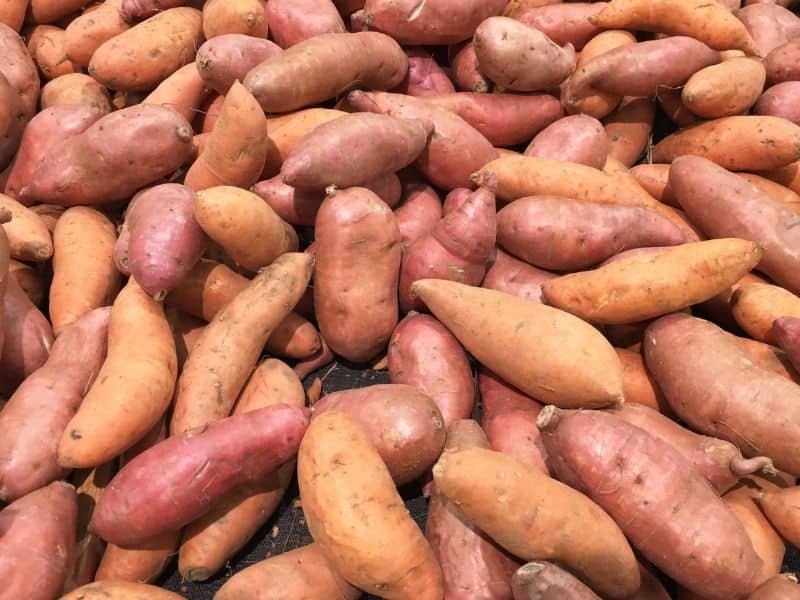If you’ve been to the grocery store lately, you might have noticed a sign on the produce aisle that reads “sweet potatoes — also known as kumara.” Wait, what? Are sweet potatoes and kumara the same thing?
The short answer is yes! Sweet potatoes and kumara are the same plant species – Ipomoea batatas. Both sweet potatoes and kumara came from South America and were first cultivated by Maori settlers centuries ago.

The name “kumara” is a Maori word for a sweet potato adopted by other cultures in New Zealand, Australia, and other parts of Oceania.
So when you see kumara in a recipe or at your local grocery store, rest assured that it is just another name for the typical sweet potato!

About Kumara
What Is It?
Kumara is a root vegetable native to South America but is now popular in many parts of the world. It is also known as sweet potato and is related to the morning glory family.
It has an elongated shape, smooth, thin skin, and a firm, starchy texture. It can be found in shades of yellow, orange, red, purple, or white.
Nutritionally speaking, kumara is high in dietary fiber and potassium. It also contains vitamins A and C, calcium, magnesium, iron, and phosphorus. These nutrients make kumara a great addition to any diet as it helps promote healthy digestion and bone health.
The Origin Story
The debate around whether sweet potato and kumara are the same is long-standing.
The Polynesian ancestors of Māori brought kūmara (sweet potato) as a food plant when they arrived in New Zealand in the 13th century. It is believed that early Polynesians had voyaged to South America and taken kūmara from there to Polynesia.
However, it wasn’t until centuries later that kumara was introduced to European settlers in New Zealand by Maori settlers in 1769.
Pre-European Maori grew several different varieties. Compared to the varieties we eat today, those kumara varieties were very small, no bigger than a finger. This led many people to believe they were two different varieties of potatoes.
The Debates
This belief has persisted for centuries, but recent genetic analysis has shown that sweet potato and kumara are, in fact, the same plant. The only fundamental differences between them are their appearance (kumara is usually red or purple while the sweet potato is usually light orange) and texture (kumara tends to be slightly firmer than a sweet potato).
Despite this scientific evidence, many people still argue that they should be treated as two separate plants due to their distinct cultural significance.
What Does Kumara Taste Like?
Kumara has a mild sweetness that can range from subtle to intense, depending on how it is cooked. It also has a creamy texture when cooked properly.
Roasting is one of the most popular ways to prepare kumara; cut it into cubes or wedges, toss it with olive oil or butter, sprinkle it with salt and pepper (or any other spices you like), then bake until golden brown and tender.
You can also boil or steam kumara for mashing or puréeing for soups or sauces. Sweet potato fries are always a hit too!
The possibilities are endless — get creative with your cooking methods to explore all the delicious flavors of this versatile root vegetable.

Types of Sweet Potatoes
Nowadays, sweet potatoes are grown in many countries worldwide and are widely available at grocery stores.
Common Varieties
Here are some of the most common types:
- Beauregard: If you’re looking for a taste sensation, America’s most widely produced type has covered you! This variety of fruit boasts vibrant orange flesh and an incredibly delicious flavor.
- Jewel: This orange-fleshed fruit is sweet and succulent, making it ideal for baking or roasting. Its mouthwatering flavor makes any dessert an unforgettable treat!
- Garnet: With its deep red flesh and subtle sweetness, this type of potato is ideal for mashing or baking fries. Its distinct flavor adds an extra zing to your favorite dishes!
- Purple: Boasting a unique combination of vibrant purple skin and subtly nutty white flesh is perfect for baking or roasting. Its flavor is sure to tantalize your taste buds!
- Covington: This potato has distinctive orange skin and deliciously sweet white flesh, making it the perfect choice for creamy mashed potatoes or crispy fries.
- Centennial: This delightful citrus fruit has bright orange skin and sweet yellow flesh. It adds zest to your baking recipes and savory roasting dishes, making it an ideal ingredient for any occasion!
- Hernandez: With its delightful orange skin and luscious yellowish-orange flesh, this type of fruit carries a delightfully sweet flavor that is perfect for baking or roasting.
- O’Henry: Boasting a bright orange skin, this type of fruit exhibits an even more sumptuous yellowish-orange flesh, with its sweetness amplified by nuanced hints of honey and cinnamon. When cooked properly, it is unrivaled in flavor!
Different Varieties of Kumara
New Zealand is home to various kūmara, but only three are commercially available.
- Owairaka Red (Garnet): This is the most frequently seen option, which possesses a creamy white interior and is usually labeled as Red.
- Gold kūmara: Known as Toka Toka Gold, with its golden skin and flesh, this type is known for its sweet taste that surpasses the flavor of red varieties.
- Orange kūmara (Beauregard): It has rich orange flesh and is sweeter than red and gold. Beauregard kūmara can be used instead of yams in North American recipes.
These sweet potatoes have an orange or yellow flesh and a sweet flavor that makes them popular for baking, frying, roasting, mashing, and making fries.

FAQs
What do they call sweet potatoes in Australia?
Sweet potatoes are known as kumara in New Zealand, but in Australia, they are commonly referred to as “sweet potatoes.” They may also be referred to as yams or boniato.
Why is kumara better than potato?
Kumara, also known as sweet potatoes, are generally healthier than regular potatoes. It is higher in fiber and contains more vitamins and minerals than regular potatoes. They are also lower in calories and carbohydrates, making them a better choice for those looking to manage their weight.
Kumara has more vitamin A than regular potatoes, which is important for eye health and immunity. They also contain higher vitamin C, B6, calcium, potassium, and magnesium levels. These vitamins and minerals help support healthy bones, muscles, and the immune system.
What color kumara is healthiest?
The answer depends on what nutrients you’re looking for.
- Red kumara contains more vitamin A than any other, making it an excellent choice for supporting healthy eyesight.
- Gold kumara has the highest dietary fiber and potassium levels, making them great for digestive health and maintaining normal blood pressure levels.
- Orange kumara is packed with beta-carotene and vitamin C, which helps boost immunity and protect against disease.
- And finally, purple kumara has the highest antioxidants to protect your cells from damage caused by free radicals.












